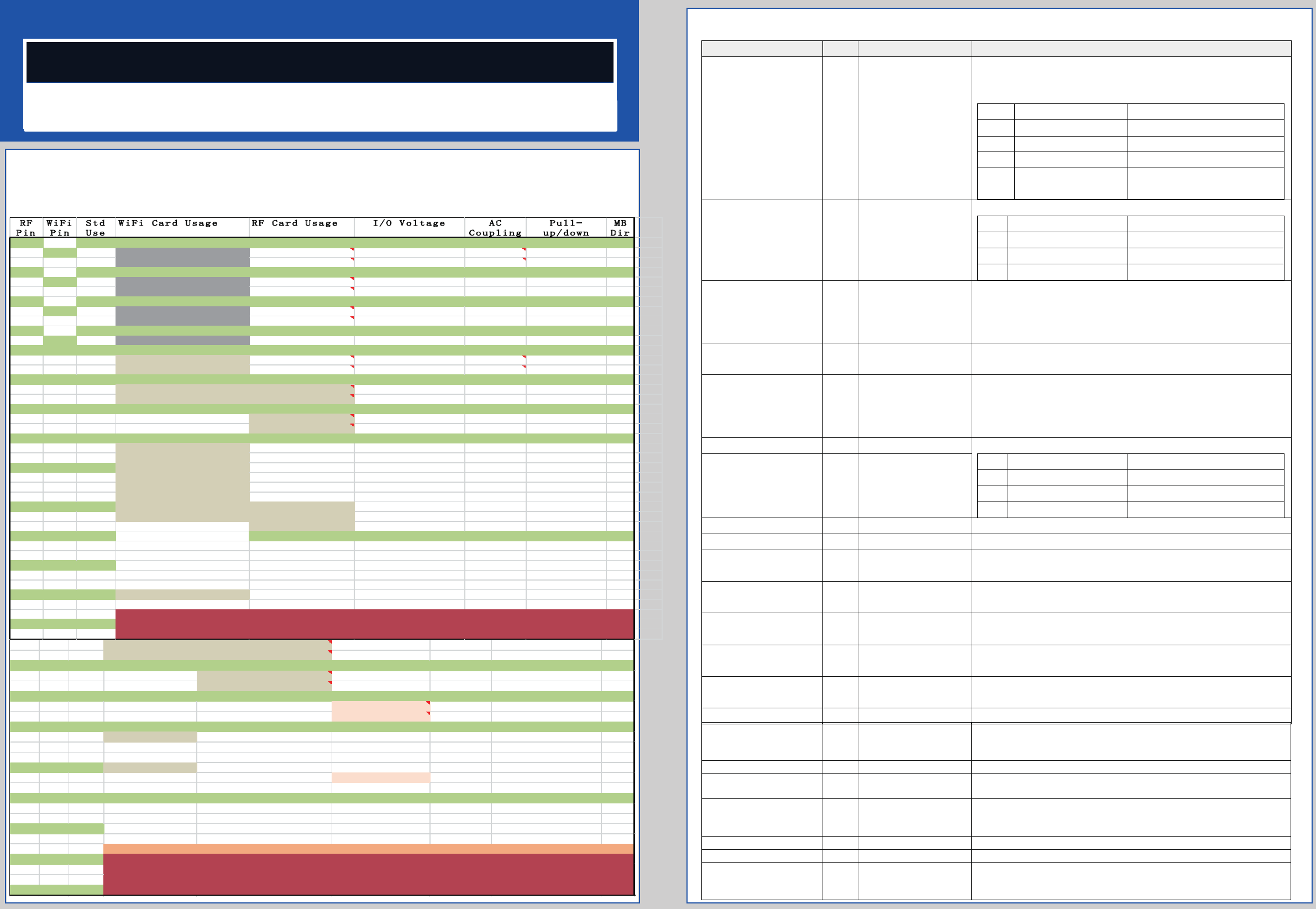Nokia Solutions and Networks FZCWM2A1 Wi-Fi AP Module 802.11 ac User Manual M2A AC210m front
Nokia Solutions and Networks, OY Wi-Fi AP Module 802.11 ac M2A AC210m front
Contents
- 1. User Manual (Statements) rev.pdf
- 2. User Manual rev.pdf
- 3. User Manual (System)
User Manual rev.pdf

Interface Definition
AC210MWi-Fi AP Module Datasheet
Introduction
The AC210M is a high-performance 2x2 802.11a/b/g/n/ac Wi-Fi AP module. It supports simultaneous operation of 2.4 GHz and
5 GHz frequency bands. The module provides two MMCX RF connectors for combined 2.4G and 5G radio and one 60-pin
board-to-board connector for connection to the host system.
The module communicates with the host system through an 82-pin connector (the Wi-Fi modules populate 60-pin only).
The connector on the module is Molex 171810-1115.
The connector definition follows Nokia RF and WiFi Card Interface Pinout.xlsx rev 11.
Signal Definition
RF
Pin
WiFi
Pin
Std
Use
WiFi Card Usage RF Card Usage I/O Voltage AC
Coupling
Pull-
up/down
MB
Dir
1 - Gnd not present GND
2 - DP not present SYNCINB0_MB_RF_DN lvds_1.8v - - O
3 - DP not present SYNCINB0_MB_RF_DP lvds_1.8v - - O
4 - Gnd not present GND
5 - DP not present SERDOUT1_RF_MB_DN cml_1.8v mb, 0.1uF - I
6 - DP not present SERDOUT1_RF_MB_DP cml_1.8v mb, 0.1uF - I
7 - Gnd not present GND
8 - DP not present SERDIN0_MB_RF_DN cml_1.8v rf, 0.1uF - O
9 - DP not present SERDIN0_MB_RF_DP cml_1.8v rf, 0.1uF - O
10 - Gnd not present GND
11 - Extra not present GP_INTERRUPT cmos_[VDD_IF] - mb, 4.7K, gnd I
12 1 Gnd GND GND
13 2 DP Reserved SYNCOUTB0_RF_MB_D
P
lvds_1.8v - - I
14 3 DP Reserved SYNCOUTB0_RF_MB_D
N
lvds_1.8v - - I
15 4 Gnd GND GND
16 5 DP SGMII_1_WIFI_MB_DP SERDOUT2_RF_MB_DP
s
gmii_1.2v/cml_1.8
v
mb, 0.1uF - I
17 6 DP SGMII_1_WIFI_MB_DN SERDOUT2_RF_MB_DN
s
gmii_1.2v/cml_1.8
v
mb, 0.1uF - I
18 7 Gnd GND GND
19 8 DP SGMII_0_WIFI_MB_DP SERDOUT3_RF_MB_DP
s
gmii_1.2v/cml_1.8
v
mb, 0.1uF - I
20 9 DP SGMII_0_WIFI_MB_DN SERDOUT3_RF_MB_DN
s
gmii_1.2v/cml_1.8
v
mb, 0.1uF - I
21 10 Gnd GND GND
22 11 DP Reserved RX_MYK_ENABLE cmos_[VDD_IF] - rf, 4.7K, gnd O
23 12 DP Reserved RX_LNA_ENABLE_MAI
N
cmos_[VDD_IF] - rf, 4.7K, gnd O
24 13 Gnd Reserved RX_LNA_ENABLE_DIV cmos_[VDD_IF] - rf, 4.7K, gnd O
25 14 Extra Reserved TX_MYK_ENABLE cmos_[VDD_IF] - rf, 4.7K, gnd O
26 15 Extra Reserved TX_KEY_MAIN cmos_[VDD_IF] - rf, 4.7K, gnd O
27 16 Extra Reserved TX_KEY_DIV cmos_[VDD_IF] - rf, 4.7K, gnd O
28 17 Gnd Reserved TR_SWITCH_MAIN cmos_[VDD_IF] - rf, 4.7K, gnd O
29 18 DP Reserved TR_SWITCH_DIV cmos_[VDD_IF] - rf, 4.7K, gnd O
30 19 DP I2C_9550_SCL (for test
)
Reserved n/c on mb - - n/a
31 20 Gnd
I2C_9550_SDA (for test)
GND
n/c on mb wifi slot
- - n/a
32 21 DP TRSTn GPIO4 (TRSTn) n/c on mb - - n/a
33 22 DP TDO GPIO5 (TDO) n/c on mb - - n/a
34 23 Gnd TDI GPIO6 (TDI) n/c on mb - - n/a
35 24 DP TMS GPIO7 (TMS) n/c on mb - - n/a
36 25 DP TCK GPIO8 (TCK) n/c on mb - - n/a
37 26 Gnd Reserved TEST n/c on mb - rf, 1K, gnd n/a
38 27 DP 5V_SENSE 5V_SENSE ana_5.1v - - I
39 28 DP VCC_5.1V VCC_5.1V
40 29 Gnd VCC_5.1V VCC_5.1V
41 30 Extra VCC_5.1V VCC_5.1V
58 36 DP
SGMII_1_MB_WIFI_D
P
SERDIN2_MB_RF_DP
s
gmii_1.2v/cml_1.8
v
rf
/wifi, 0.1
uF
- O
59 37 DP
SGMII_1_MB_WIFI_D
N
SERDIN2_MB_RF_DN
s
gmii_1.2v/cml_1.8
v
rf
/wifi, 0.1
uF
- O
60 38 Gnd GND GND
61 39 DP SGMII_0_MB_WIFI_D
P
SERDIN3_MB_RF_DP
s
gmii_1.2v/cml_1.8
v
rf
/wifi, 0.1
uF
- O
62 40 DP SGMII_0_MB_WIFI_D
N
SERDIN3_MB_RF_DN
s
gmii_1.2v/cml_1.8
v
rf
/wifi, 0.1
uF
- O
63 41 Gnd GND GND
64 42 DP I2C_SCL I2C_SCL cmos_3.3v -
mb
1K; rf/wifi 10K, 3.
3v
I/O
65 43 DP I2C_SDA I2C_SDA cmos_3.3v -
mb
1K; rf/wifi 10K, 3.
3v
I/O
66 44 Gnd GND GND
67 45 Extra Reserved SPI_SCLK cmos_[VDD_IF] - rf, 4.7k, gnd O
68 46 Extra UART_WIFI_MB SPI_MISO cmos_[VDD_IF] - mb, 4.7k, VDD_IF I
69 47 Extra UART_MB_WIFI SPI_MOSI cmos_[VDD_IF] - rf, 4.7k, VDD_IF O
70 48 Gnd Reserved SPI_CS_n cmos_[VDD_IF] - rf, 4.7k, VDD_IF O
71 49 DP I2C_WP I2C_WP cmos_3.3v - rf, 4.7k, 3.3v O
72 50 DP RESET_n RESET_n cmos_[VDD_IF] - rf/wifi, 4.7K, VDD_I
F
O
73 51 Gnd GND GND
74 52 DP LED_WLAN_0 GPIO0 cmos_[VDD_IF] - mb, 10K, VDD_IF I, I/O
75 53 DP LED_WLAN_1 GPIO1 cmos_[VDD_IF] - mb, 10K, VDD_IF I, I/O
76 54 Gnd LED_WLAN_2 GPIO2 cmos_[VDD_IF] - mb, 10K, VDD_IF I, I/O
77 55 DP LED_WLAN_3 GPIO3 cmos_[VDD_IF] - mb, 10K, VDD_IF
I, I/O
78 56 DP VDD_IF VDD_IF (1.8v from MB, 2.5v from FPGA Dev Card)
79 57 Gnd VCC_5.1V VCC_5.1V
80 58 DP VCC_5.1V VCC_5.1V
81 59 DP VCC_5.1V VCC_5.1V
82 60 Gnd VCC_5.1V VCC_5.1V
Signal Type Description Parameters
SGMII_0_MB_WIFI_DN
SGMII_0_MB_WIFI_DP
I SGMII Differential
Input
The signal is AC coupled. Proper biasing is provided on the module
receiver.
Vih Input Single Voltage High -/-/1480 (mV, min/typ/max)
Vil Input Single Voltage Low 520/-/- (mV, min/typ/max)
Vidth Input Differential Threshold -50/-/50 (mV, min/typ/max)
Vio Internal Offset Voltage 800/900/1000 (mV,min/typ/max)
Rin Receiver Differential Input
Impedance
100ohm
SGMII_0_WIFI_MB_DN
SGMII_0_WIFI_MB_DP
O SGMII Differential
Output
Voh High Level Output Voltage -/1050/1195 (mV, min/typ/max)
Vol Low Level Output Voltage 200/750/-(mV, min/typ/max)
VoD Output Differential Voltage 300mV
VoS Output Offset Voltage 500/900/1070(mV, min/typ/max)
SGMII_1_MB_WIFI_DN
SGMII_1_MB_WIFI_DP
SGMII_1_WIFI_MB_DN
SGMII_1_WIFI_MB_DP
NC Reserved The signals are not connected on the module.
WIFI_PRESENCE_n O Board Present
Indication
On module the signal is pulled to GND with a 0 ohm resistor.
RESET_n I Reset External reset to the module. It is internally pulled down GND by 10k
ohm resistor. This reset signal is connected to module CPU through
GPIO..
The signal must be driven by 1.8V logic.
IIC_SDA IO I2C Data
Vih Input Voltage High 2/-/3.5 (V, min/typ/max)
Vil Input Voltage Low -0.5/-/0.8 (V, min/typ/max)
Voh High Level Output Voltage 2.2/-/3.3 (V, min/typ/max)
Vol Low Level Output Voltage -0.2/-/0.6 (V, min/typ/max)
IIC_SCL I I2C Clock
LED_WLAN_0 OC 2.4G LED Open collector driven, sink maxim 20mA current when LED lit
LED_WLAN_1 OC 5G LED Open collector driven, sink maxim 20mA current when LED lit
LED_WLAN_2 OC LED_Reserved (Reserved) Open collector driven, sink maxim 20mA current when
LED lit
LED_WLAN_3 OC LED_Reserved (Reserved) Open collector driven, sink maxim 20mA current when
LED lit
VCC_5.1V POW
ER
5V Power Input 5.1V+/-0.15V. 0~3A
5V_SENSE POW
ER
5V Power Sense The 5V sense is directly wired on the Wi-Fi module from VCC_5.1V
UART_WIFI_MB O UART signal from MB
to Module
The signal must be driven by 1.8V logic
UART_MB_WIFI I UART signal from The signal must be driven by 1.8V logic
I2C_WP I I2C write protect signal On module this signal is connected to EEPROM write protection,
driving high to enable EEPROM write protection.
The signal must be driven by 3.3V logic
VDD_IF I 1.8V voltage On module this is 1.8V voltage level reference
I2C_9550_SCL
(for test)
O I2C clk signal from
9550
On module this is connected to CPU GPIO16 for manufacturing test
only
I2C_9550_SDA
(for test)
I/O I2C data signal
between 9550 and
slave units
On module this is connected to CPU GPIO 21 for manufacturing test
only
Reserved NC Reserved pins The reserved pins are NOT connected on the Wi-Fi module
GND GND GND GND
JTAG I/O JTAG debug pins Connected to CPU EJTAG port for device debug. This interface shall
not be daisy chained on MB. This interface must be driven by 2.5V
logic

Package information
1. PCBA Label 1
PCBA Label:
2D data Matrix, no printed label.
2. PCBA Label 2
Label on PCBA board---Nokia SN
Label size : 30 x 7mm
Material : heat resisting PET
Colors: White material, printing in black
Font Arial size is 3pt
Barcode: code 128B
Label on PCBA board---Certification information
Label size : 15 x 5mm
Material : heat resisting PET
Colors: White material, printing in black
Font Arial size is 3pt
Power Supply
Power up ramping
Operation Environment
Safety and EMC
Power consumption Average power consumption of the module under typical operation mode shall be less than 10W. Peak power supply
current is less than 3A at 5.1V.
Capacitive load
The module shall not present a capacitive load to the mainboard larger than 1500uF
The module is not designed for hot swapping. The power supply ramping speed is not controlled by the module itself.
Operating temperature
The module shall support a low operating temperature limit of -40C.
The upper operating temperature limit will be determined by empirically measuring the case temperature of the critical
components and ensuring that none of the individual component limits are violated while the module is operating within
the Nokia host platform. Once data is available, this entry shall be updated with the upper operating temperature limit.
The module is expected to withstand heatsink body temperature of 80C when proper heatsinking is in place.
Operating humidity
5% to 95% non-condensing
-40°C to +85°C
Storage temperature
Safety This WiFi module design shall not prevent the host product from obtaining NRTL Listing 60950 (US &CA), CB with
IEC/EN 60950-1 (Basic safety certificate for worldwide marketing)
EMC/EMI GB 9254 -2008(Class B of Product) , EN55022, CISPR 22:2006 , EN55024, CISPR 24:2010
The noisy circuits such as crystal, CPU, DDR, etc. are well shielded to avoid generating unwanted emission impacting
the LTE/3G band receiver.
Unwanted Emission
HBM 1.5KV
ESD
Elevations
Environment
Surge
86kPa~106kPa
Shall be RoHS 2011/65/EU compliant (RoHS 6 compliant, no Pb);
WEEE 2002/96/EC recyclable materials requirements
Telcordia GR-63-CORE
The module does not provide onboard surge protection.